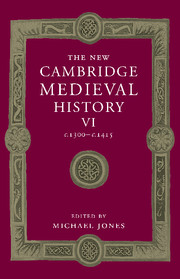Book contents
- Frontmatter
- Part I General Themes
- 1 Introduction
- 2 The Theory and Practice of Government in Western Europe in the Fourteenth Century
- 3 Currents of Religious Thought and Expression
- 4 The Universities
- 5 Rural Society
- 6 Urban Life
- 7 Plague and Family Life
- 8 Trade in Fourteenth-Century Europe
- 9 Chivalry and the Aristocracy
- 10 Court Patronage and International Gothic
- 11 Architecture
- 12 Literature in Italian, French and English: Uses and Muses of the Vernacular
- Part II The States of the West
- Part III The Church and Politics
- Part IV Northern and Eastern Europe
- Appendix Genealogical Tables
- Primary Sources and Secondary Works Arranged by Chapter
- Index
- Frontispiece
- Plate section
- Map 4 Europe's trade, c. 1300
- Map 5 Europe's trade, c. 1400
- Map 7 The Hundred Years War to 1360
- Map 15 Russia, c. 1396
- Map 17 The Byzantine empire in the 1340s
- References
3 - Currents of Religious Thought and Expression
from Part I - General Themes
Published online by Cambridge University Press: 28 March 2008
- Frontmatter
- Part I General Themes
- 1 Introduction
- 2 The Theory and Practice of Government in Western Europe in the Fourteenth Century
- 3 Currents of Religious Thought and Expression
- 4 The Universities
- 5 Rural Society
- 6 Urban Life
- 7 Plague and Family Life
- 8 Trade in Fourteenth-Century Europe
- 9 Chivalry and the Aristocracy
- 10 Court Patronage and International Gothic
- 11 Architecture
- 12 Literature in Italian, French and English: Uses and Muses of the Vernacular
- Part II The States of the West
- Part III The Church and Politics
- Part IV Northern and Eastern Europe
- Appendix Genealogical Tables
- Primary Sources and Secondary Works Arranged by Chapter
- Index
- Frontispiece
- Plate section
- Map 4 Europe's trade, c. 1300
- Map 5 Europe's trade, c. 1400
- Map 7 The Hundred Years War to 1360
- Map 15 Russia, c. 1396
- Map 17 The Byzantine empire in the 1340s
- References
Summary
the main determinant of religious thought in the fourteenth century, which would eventually affect every aspect of public worship and private prayer, was the concentrated effort, in the previous century, to marshal, state logically and resolve questions according to an agreed theological language, establishing thereby a coherent method of religious education. The enduring issues of God’s relation to the world, the human soul and the nature of redemption were not resolved, but they had been successfully contained within an abstract and largely Aristotelian language, and were generally discussed by a trained and conscious elite at Paris or its satellites in Oxford, Cambridge and the schools of the friars. The attempt to resolve them had created and continued to create philosophical syntheses of greater or less cohesion. That of Thomas Aquinas, promoted by the Order of Preachers and universally known after his canonisation in 1323, was matched in the first decades of the century by the more amorphous body of ideas associated with the Franciscan doctors Duns Scotus, Peter Auriol and François de Meyronnes: among whom the influence of current logic brought about, some twenty years later, a critical reexamination of theological language, associated with William of Ockham, and as the moral and social aspects of religious thinking began to dominate debate, a vigorous return to Augustinian ideas. These bodies of ideas did not create distinct schools of thought: virtually all theologians of the fourteenth century were independent thinkers who can be classified as Augustinians, Thomists, Scotists or followers of the via moderna – only in a broad sense.
- Type
- Chapter
- Information
- The New Cambridge Medieval History , pp. 42 - 65Publisher: Cambridge University PressPrint publication year: 2000

